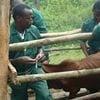Explore all the information on
Swine management
Pig production is the systematic rearing of pig breeds on scientifically based management principles for economic benefit. The main objectives of pig production are to provide consumers with pig meat and related products and to generate income for farmers.
Pig production plays a significant role in the livestock industry, providing an important source of protein and other valuable products. The systematic approach to pig rearing ensures that the pigs are healthy and well-cared for, which in turn leads to better quality products and higher yields. The focus on scientific principles and efficient management helps to reduce waste and increase profitability for farmers.
A swine producer who masters the art of good management has excellent profit opportunities. This is especially true with disease prevention and control. A healthy herd of good-growing, quality breeding animals — adequately fed and housed — provides maximum profit opportunities for the owner who does not over-spend for facilities and/or feed.
The first batch of early bird registration is available until 11:59 PM, January 31st, 2022
Registration for the 26th Congress of the International Pig Veterinary Society (IPVS), the world´s most important scientific event...
Comments : 0
Recommendations: 0
United Pork Americas, an event to be held in September 2022, was designed to spread knowledge about the international market and also the main technical issues of pig farming on a global level.
Networking is one of the strong points of the event, with the...
Comments : 0
Recommendations: 0
Introduction As the economic success of sow husbandry relies very much, but not solely, on the ability of sows to produce a high number of piglets per sow per year, a high sow litter size contributes to this goal. Genetic selection for higher litter size has resulted in a steady increase in sow litter size in the last decades, and this increase in litter size still continues. For example, in the Netherlands, sow litter size (total number born) has increased...
Comments : 0
Recommendations: 0
Introduction Despite the wealth of information on the many factors that affect sexual maturation and the early breeding performance of gilts, it has been difficult to establish the needed protocols that produce a consistent supply of “good quality” replacement females. In the context of the latest genotypes available to the production industry, it is important to keep addressing the changing biology of the nucleus sows from which replacement...
Comments : 0
Recommendations: 0


Evonik upgrades logistics infrastructure for MetAMINO® in Antwerp
Suggested link
Introduction Pork’s historic position as the world’s most popular meat is no more. 2019 was characterized by the explosion of African Swine Fever in China and subsequent slaughter of approximately half of that country’s pigs, representing about 25% of the world's production. Allowing for this catastrophe the exorable rise in the global consumption of chicken ensured it always going to result in its accession to No.1 spot worlds, but...
Comments : 1
Recommendations: 1
This systematic review aimed to assess the effectiveness of pre-harvest interventions to control the main foodborne pathogens in pork in the European Union. A total of 1180 studies were retrieved from PubMed® and Web of Science for 15 pathogens identified as relevant in EFSA's scientific opinion on the public health hazards related to pork (2011). The study selection focused on controlled studies where a cause-effect could be attributed to the interventions tested, and...
Comments : 0
Recommendations: 0


Will New Version of GMP Boost the Veterinary Drugs Industry?
Suggested link
Guilherme Rosa (University of Wisconsin-Madison) mentions training, adaptation and possible costs among the challenges, in this Swine It interview with host Laura Greiner....
Comments : 0
Recommendations: 0
Mike Tokach (Kansas State University) comments on complex diets and feeder adjustments, in this Swine It interview with host Laura Greiner....
Comments : 0
Recommendations: 2
Guilherme Rosa (University of Wisconsin-Madison) talks about the benefits of technology in this Swine It interview with host Laura Greiner....
Comments : 0
Recommendations: 1
Liz Wagstrom (National Pork Producers Council) talked about surveillance and sample collection, in this Swine It interview with host Laura Greiner....
Comments : 0
Recommendations: 0
Maternal investment, sow behavioural needs and criteria for housing design The reproductive strategy of producing large broods and smaller young, resulting in a higher mortality rate, fits the picture of domestic pigs remarkably well (reviewed by Drake et al. 2008). The average litter size in domestic sows is around 12 to 14 piglets, but litters of above 20 piglets are not uncommon even in gilts, although the number of functional teats is usually between 14...
Comments : 0
Recommendations: 0
The Animal AgTech Innovation Summit will be live online on October 19-20, 2021 for two days of interactive live-streamed sessions, roundtable discussion groups and 1-1 video meetings.
David Speller, OPTIfarm CEO/Founder, will be one of the distinguished speakers at the event and in this...
Comments : 0
Recommendations: 1


Evonik upgrades logistics infrastructure for MetAMINO® in Antwerp
Suggested link
INTRODUCTION Estrus synchronization is a well-established tool for the reproductive management of a variety of livestock species. Manipulating the estrous cycle of domestic animals is thus essential for improving livestock productivity, as it helps to generate more income for the farmer through the utilization of assisted reproductive techniques like artificial insemination, in vitro fertilization and embryo transfer technologies. In gilts, estrus manipulation is being...
Comments : 0
Recommendations: 0
Introduction During the last decades, the use of data by farmers has been limited. Most of the systems used were simple and mainly focused on the management of farm tasks, with limited or no capacity of analysis. Integration of data from different devices or farms was also difficult, and there was little applied knowledge on the value of data in the strategic decision-making. Another weak point, not solved so far, is the lack of support services in use of...
Comments : 0
Recommendations: 1


Will New Version of GMP Boost the Veterinary Drugs Industry?
Suggested link
Introduction
Talk about traditional bacteria in pigs, and Mycoplasma hyopneumoniae (M. hyopneumoniae) will be among the first ones to be mentioned. The “tradition” of this microorganism may be based on the fact that it has been recognized as a swine-specific pathogen for more than five decades, that it is prevalent in most areas where pigs are raised, and that it is common to accept its circulation in pig herds....
Comments : 0
Recommendations: 1
The global swine production industry has experienced a revolution in the last 30 to 40 years. Forty years ago, production was geographically centralized (i.e., all production activities were centrally located), small scale and outdoors. Producers were knowledgeable in many areas, but a specialist in none and few had employees. Swine production has now transitioned to where many of the production activities are geographically decentralized at specialized facilities. The...
Comments : 0
Recommendations: 0
Introduction
An important work function for the practicing veterinarian is to solve various problems in swine herds. Diagnostics and making a diagnosis are an important part of solving a problem.
The diagnosis is central for describing the problem, identifying the problem and, finally, making a change that will hopefully lead to the problem being solved.
A diagnosis can either be made for individual animals or,...
Comments : 0
Recommendations: 0
Introduction Resilience was historically ignored in commercial swine breeding programs. One reason was that breeding companies need to supply high health animals to the commercial sector of the swine industry. Nucleus herds needed to be naïve or at least negative for major diseases such as porcine reproductive and respiratory syndrome virus (PRRSv), Actinobacillus pleuropneumoniae (APP), Mycoplasma hyopneumonaie , and other major diseases....
Comments : 0
Recommendations: 0
Dr. Chris Chase (South Dakota University) discussed what to do in a pandemic situation and how to apply this knowledge to pig production, during this Swine It interview with host Márcio Gonçalves....
Comments : 0
Recommendations: 0
Dr. Flaviana Gottardo and Dr. Annalisa Scollo (University of Padova, Italy) gave practical recommendations for producers on this issue during this Swine It interview with host Márcio Gonçalves....
Comments : 0
Recommendations: 1





















